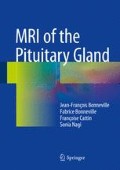Abstract
Hamartomas of the tuber cinereum are not true tumoral lesions but rather congenital malformations formed by accumulation of normal neurons and glia from the tuber cinereum in an unusual location. The tuber cinereum, part of hypothalamus, is a hollow eminence of gray matter located between the optic chiasm and the mammillary bodies. Hamartomas of the tuber are usually revealed by a very early precocious puberty and gelastic seizures; less frequently, the only clinical manifestation is a developmental delay in relation with isolated GH deficit or a panhypopituitarism. Cognitive impairment and behavioral disorders including aggressiveness are infrequent and less known. The relationships of the hamartoma to the third ventricle, infundibulum, and mammillary bodies are appreciated on multiplanar MR studies. Association of hamartoma to the mammillary bodies is a particularly important radiological finding, as the anterior thalamic nuclei included in mammillary bodies are involved in the generation of seizures. There is no correlation between the clinical symptoms and the size of the hamartoma. Arita classified the hypothalamic hamartomas into two categories: the parahypothalamic type when the hamartoma is attached to the floor of the third ventricle at the origin of precocious puberty without seizures, and the intrahypothalamic type when the hamartoma is enveloped by the hypothalamus causing medically intractable seizures, behavioral disturbances, mental retardation, and precocious puberty. On MR studies, the hypothalamic hamartoma appears as a round suprasellar mass, sessile or pedunculated. The size is variable, from a few millimeters to 5 cm in diameter. The signal is similar to that of gray matter on all sequences (Figs. 38.1 and 38.2). However, T2-hyperintense foci are occasionally seen (Fig. 38.3); in these cases, the differential diagnosis with hypothalamic glioma can be difficult. There is no enhancement after gadolinium injection. Cysts and calcifications are exceptional. Diagnosis of intrahypothalamic hamartoma is a challenge: coronal high-resolution T2WI focused on the hypothalamic region is mandatory in young patients presenting with intractable seizures and/or isolated severe behavioral troubles even in the absence of precocious puberty (Fig. 38.4). MR spectroscopy can be normal or shows a slight decrease in N-acetylaspartate, and an increase in choline and myoinositol (Fig. 38.5). Non-enhancing hypothalamic-chiasmatic glioma is the only differential diagnosis of hamartoma.
Access this chapter
Tax calculation will be finalised at checkout
Purchases are for personal use only
Further Reading
Arita K, Ikawa F, Kurisu K et al (1999) The relationships between magnetic resonance findings and clinical manifestations of hypothalamic hamartoma. J Neurosurg 91:212–220
Boyko OB, Curnes JT, Oakes WJ, Burger PC (1991) Hamartomas of the tuber cinereum: CT, MR and pathologic findings. AJNR Am J Neuroradiol 12:309–314
Martin DD, Seeger U, Ranke MB, Grodd W (2003) MR imaging and spectroscopy of a tuber cinereum hamartoma in a patient with growth hormone deficiency and hypogonadotropic hypogonadism. AJNR Am J Neuroradiol 24:1177–1180
Author information
Authors and Affiliations
Rights and permissions
Copyright information
© 2016 Springer International Publishing Switzerland
About this chapter
Cite this chapter
Cattin, F. (2016). Hamartoma of the Tuber Cinereum. In: MRI of the Pituitary Gland. Springer, Cham. https://doi.org/10.1007/978-3-319-29043-0_38
Download citation
DOI: https://doi.org/10.1007/978-3-319-29043-0_38
Published:
Publisher Name: Springer, Cham
Print ISBN: 978-3-319-29041-6
Online ISBN: 978-3-319-29043-0
eBook Packages: MedicineMedicine (R0)

